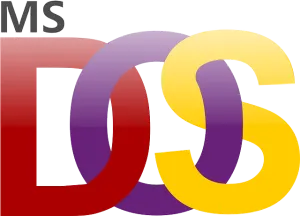If you are a computer enthusiast or learning about the history of computers or programming languages then you might have come across the term “DOS”. We hear about this term only when we talk about computers in the mid-80s and 90s.
In this article, we are going to learn about the DOS, how it worked, and its pros and cons.
Content
What is a Disk Operating System (DOS)?
DOS is the oldest type of operating system that runs from a disk drive. DOS is a Character User Interface (CUI) operating system. This is quite different from today’s GUI (Graphical User Interface) based operating systems. DOS works on commands that are used to manage and control different hardware components and the memory of the computer.
What is MS-DOS?

MS-DOS also known as Microsoft DOS stands for Microsoft Disk Operating System. It was originally known as 86 DOS. It was developed for PCs with x86 microprocessors. It is a non-graphical and command-driven OS in comparison to Windows.
For example, to see files in Windows we double-click the folder in Windows Explorer but in the case of MS-DOS, we used the command cd to navigate to the folder and then use the dir command to list all the files in that folder. MS-DOS is still alive because of its compactness, efficiency, and little maintenance but has not received any newer version since 1997.
Booting with MS-DOS
- When we turn on the computer, the Basic Input-Output System (BIOS) reads the data and programs. And loads it into the memory RAM (Random Access Memory). This is known as booting.
- During the DOS booting process the reading of the following files into memory takes place IO.SYS, COMMAND COM, and MSDOS.SYS.
- IO.SYS is the basic Input-Output Program that provides the interlinking of hardware and software of the system.
- MSDOS.SYS handles disk buffering and file management. It remains permanently in memory.
- COMMAND COM command processor also known as a command interpreter displays the system prompt and handles the user command.
In addition to the above, two text files help to control the boot process.
- Config.sys – Includes commands that help to configure hardware components.
- autoexec.bat – Includes startup commands.
Basic DOS Commands
Some basic commands of the MS-DOS are as-
- Directory Commands
- DIR- Used for listing files and directories.
- MD- This command makes a new directory.
- CD- Used to enter or exit from any directory.
- PATH- Used to display or set directories for executable files.
- File Management Commands
- COPY- Used to copy any file to another location or directory.
- DEL- Used to erase any file from the disk
- XCOPY- When we need to copy a directory instant of a file from one location to another.
- REN- Used to change the name of any file or directory
- General Commands
- TIME- Display the current time.
- DATE- Display the current Date.
- TYPE- Used to display the contents or text of any file to the display.
- PROMPT- Customizes the DOS command prompt.
Features of MS-DOS
- MS-DOS is a 16-bit operating system.
- MS-DOS is a character-based interface system where commands are entered by the users in the command line prompt.
- MS-DOS makes file management i.e. creating, editing, deleting, etc.
- MS-DOS is a single-user operating system.
- File names in MS-DOS are limited to eight characters.
Limitations of MS-DOS
- File naming – File names in MS-DOS are limited to upper case only.
- Security – For file ownership and permissions, MS-DOS doesn’t have any built-in security.
- No multi-user – MS-DOS can run only one program at a time thus it does not support multitasking and multi-users.
- Difficult to use – As MS-DOS is a command-based OS thus, making it difficult for beginners to use as it requires commands to be remembered for specific actions.
Advantages of MS-DOS
- It is a very lightweight operating system.
- It has less latency as it does not support multitasking.
- The system boot-up process is faster in MS-DOS compared to other OS.
Disadvantages of MS-DOS
- It is limited to very few applications.
- It has a command-line interface that is not very user-friendly.
Windows OS is easy to use as they have GUI and we can easily hover here and there with the help of a mouse but today also Windows OS continues to support an MS-DOS-like user interface for special purposes. To know the basic idea press Win + R in your Windows OS then typed cmd a pop-up appears and now you are in DOS. so, this is the end of the article. Thanks for reading.
